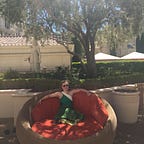Scholastic’s Princess and Nail Art Problem
Scholastic Book Club was, at the time I entered elementary school, the best thing that had ever happened to me. A thrill always ran through me during the ceremonial handing-out-of-the-Scholastic-order-forms in class. I don’t know if it was the idea that, as an eight-year-old, I could place an order for something and expect it to arrive in class in two to four weeks, or if it was simply the fact that the flyer represented possibility and the promise of great books.
The thrill continues, even though now it’s my children’s flyers that I’m scouring rather than my own. Together, we go through them with a red pen and circle the books we want. There are often wonderful offerings: Esperanza Rising, Sarah, Plain and Tall, the work of Rodman Philbrick, the ever-available Harry Potter, and Kate DiCamillo’s canon. It’s been a treat to introduce to my children to books like Stone Fox and the work of O. Henry, as well. One of most recent favorites is Interstellar Cinderella, in which Cindy is now a space technician.
But there are also the kinds of books on these flyers that gnaw at me. The kind of books (and non-book items) that were never part of the Scholastic flyers of my youth. A random assortment includes “Candy Fairies: Magic Heart Set, with Sparkly Charm Bracelet” and “Glimmer Glam: Tattoos and More!” The “I Heart Pandas Stationery Set” is a blindingly pink collection of stickers, heart stamp, and a keepsake box. On the same page of the fourth-grade flyer, we see the classic Bud, Not Buddy alongside a “Hair Tattoo Kit.” My kindergartener is bombarded with stories about dogs who are princesses.
One of my least favorites is the “Secret Stuff for Girls Only”…thing. It’s not a book, but a journal with two locks, including one to share with your bestie.
Last year, an eight-year-old girl from Britain petitioned Scholastic to stop promoting books labeled “for boys” and “for girls” at school book fairs. Her letter received a heartening response, in which Scholastic UK promised to stop making gender divisions like this at book fairs and to redesign the jackets of books that suggested such books were “for boys” or “for girls.” (Incidentally, the eight-year-old pirate fanatic had been particularly annoyed when she saw a book about pirates labeled “for boys.”) This suggests to me, and to organizations like Let Toys Be Toys, which leads a campaign called Let Books Be Books, that girls notice these things at a very young age.
And while the steps taken by Scholastic are welcome, close analysis of a year’s worth of Scholastic flyers coming home in the backpacks of my kindergartener and my third-grader suggest that the problematic “gendering” of books and assorted non-book items on offer persists. The sheer amount of sparkle, glitter, princess animals, secret journals, and cosmetic kits highlighted on your average Scholastic flyer sends a clear message to girls about the seriousness of their reading: in this case, their reading choices are frivolous. Hell, she doesn’t even have to read when she can order a hair tattoo kit. It’s hard to argue that such items appeal to “reluctant readers” (a justification often used for promoting “fluff” books to children) when there are no pages to turn.
My son, on the other hand, is subtly steered by these flyers toward war books, accounts of historical events, Guinness Book of World Records, spy and cryptography tales, and the like.
As someone who once worked in publishing, I understand that times in the industry are tough, and that Scholastic needs to make money wherever it can. But at what cost to the children who, like mine, look forward to the monthly flyers and study it the way investment bankers study the Wall Street Journal? Like stock brokers, they observe trends, draw conclusions, make assumptions about value — including, in my daughter’s case especially, their own intrinsic value. When henna tattoos and sparkle ponies are considered a fair exchange against Flora and Ulysses, we’re in a challenging space, as parents.
I argue that by focusing on its core strengths as a publisher — fine children’s literature, such as the completely non-sparkly Harry Potter series — Scholastic will do a service to the children who look to it for literary guidance. Get rid of the fluff — the sparkly charms and the super-secret diaries “for girls only.” Books. Books are the thing. Preferably sans tiaras.
